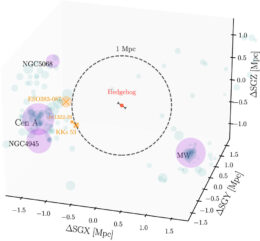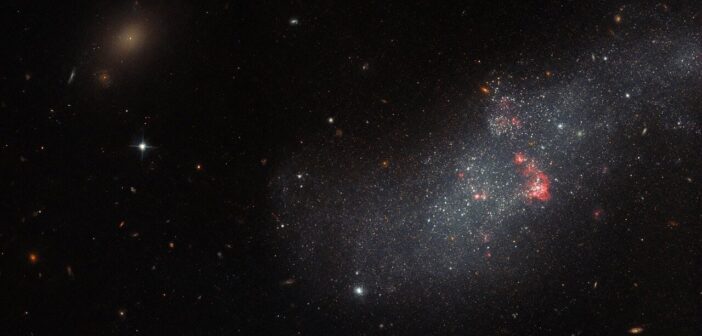Researchers have discovered an extremely isolated galaxy. The galaxy, dubbed “Hedgehog” for its small size and isolated nature, lies roughly 5.5 million light-years from the nearest galaxy group and isn’t forming any stars, making it a rarity among dwarf galaxies.

Messier 63’s faint, looping stellar stream, highlighted by the negative image surrounding the main body of the galaxy, is thought to be a disrupted dwarf galaxy. [Adapted from Giuseppe Donatiello / Michele Trungadi; Public Domain]
One Is the Loneliest Number
Small but fascinating, dwarf galaxies are the most common type of galaxy in our universe. At most containing roughly 1% as many stars as the Milky Way, these delicate galaxies are easily disrupted by the gravitational pull of larger galaxies. These interactions can pull dwarf galaxies apart into stellar streams or put a stop to their star formation.
Far from the influence of larger galaxies, though, isolated dwarf galaxies tend to churn out new stars; only 0.06% of isolated dwarf galaxies are quiescent, lacking new stars. When a quiescent dwarf galaxy is found far from other galaxies, astronomers attempt to puzzle out why the galaxy is dormant.
Discovering a Hedgehog
A Princeton University team led by Jiaxuan Li (李嘉轩) was searching for dwarf galaxies orbiting the galaxy NGC 5068 when they spotted a small galaxy cataloged as dw1322m2053. Initially flagged as a possible satellite of NGC 5068, placing it 17 million light-years away, dw1322m2053’s mottled appearance suggested that the galaxy was far closer — close enough for its irregular distribution of stars and star clusters to be faintly visible.

Three views of dw1322m2053 aka Hedgehog. The galaxy is visible at optical and near-infrared wavelengths (left and center images) but has not been detected in the ultraviolet (right image). Click to enlarge. [Li et al. 2024]
An investigation into the galaxy’s neighborhood earned it a new moniker: Hedgehog. Like its adorably prickly namesake, Hedgehog is small and solitary: there are no galaxies within 3.3 million light-years and no galaxy groups within 5.5 million light-years, making it one of the most isolated dwarf galaxies known.
How to Quench an Isolated Galaxy

A view of Hedgehog’s neighborhood. The galaxy’s closest neighbors are shown in orange. The purple circles show the virial radii of the galaxy groups. You can view an interactive version of this figure here. [Adapted from Li et al. 2024]
Li’s team found that Hedgehog is most likely a backsplash galaxy, meaning that it passed close enough to a galaxy group to have its star-forming gas stripped away before being slingshotted into empty space. Given the distance to the closest galaxy group, Centaurus A, and the age of Hedgehog’s stars, this scenario is possible, but a more refined estimate of Hedgehog’s age is necessary to fully assess this possibility.
There could be an even simpler explanation, though: with a stellar mass of just 631,000 solar masses, Hedgehog is on the small side, even for a dwarf galaxy. At such a small size, it’s possible for star formation to be halted in various ways, including by passing through a patch of intergalactic gas or by evaporating away its own star-forming gas. Future observations will help to explain why Hedgehog has been hibernating.
Citation
“Hedgehog: An Isolated Quiescent Dwarf Galaxy at 2.4 Mpc,” Jiaxuan Li et al 2024 ApJL 975 L23. doi:10.3847/2041-8213/ad5b59
